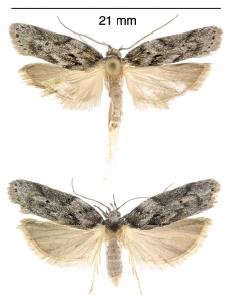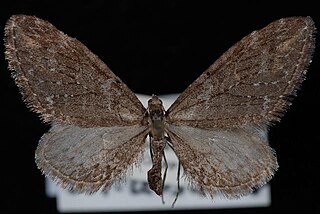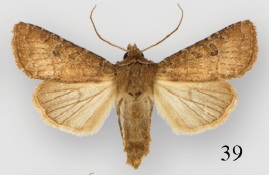
Eupithecia simpliciata, the plain pug, is a moth of the family Geometridae. It is found in the Palearctic realm, from western Europe to north-western China (Xinjiang). The species primarily colonizes wastelands, rubble and abandoned vineyards, and in Asia also salt steppes. In the Alps, the range of altitude extends up to 1200 metres.

Antaeotricha arizonensis is a moth of the family Depressariidae. It is found in the United States in the mountain ranges in south-eastern Arizona and south-western New Mexico. Although Antaeotricha arizonensis are easily differentiated within their genus through the dark spots on their forewings, the distinction between sexes of A. arizonensis can be complicated. The sexes of A. arizonensis (male&female) differentiate between themselves by distinct characteristics on their antennas and anatomy of their genitalia(Ferris, 59)
Eupithecia insolabilis is a moth in the family Geometridae first described by George Duryea Hulst in 1900. It is found in the southern United States, including Utah, Arizona and New Mexico.
Eupithecia subcolorata is a moth in the family Geometridae first described by George Duryea Hulst in 1898. It is found in western North America, from British Columbia south to Arizona and New Mexico.
Eupithecia phyllisae is a moth in the family Geometridae first described by Rindge in 1963. It is found in the US states of New Mexico and Arizona.

Eupithecia niveifascia is a moth in the family Geometridae first described by George Duryea Hulst in 1898. It is found in North America from south-western Alberta west to Vancouver Island, north to northern coastal British Columbia and south to New Mexico.
Eupithecia flavigutta is a moth in the family Geometridae first described by George Duryea Hulst in 1896. It is found in the United States in Colorado and montane forest areas in eastern Arizona and south-western New Mexico.
Eupithecia sonora is a moth in the family Geometridae. It is found in Sonora, Mexico, the Gila River Valley, New Mexico, and the Chiricahua Mountains in Arizona.
Eupithecia hohokamae is a moth in the family Geometridae first described by Frederick H. Rindge in 1963. It is found in the United States in southern Arizona and California.

Eupithecia anticaria is a moth in the family Geometridae first described by Francis Walker in 1862. It is found from eastern Newfoundland and Labrador across Canada to western British Columbia, south to northern New Mexico and Apache and Coconino counties in Arizona.
Eupithecia macfarlandi is a moth in the family Geometridae first described by Clifford D. Ferris in 2007. It is found in canyons on the east side of the Huachuca Mountains in the US state of Arizona. The habitat consists of oak and oak-conifer forests.
Eupithecia penablanca is a moth in the family Geometridae first described by Clifford D. Ferris in 2007. It is found in Carr Canyon in the US state of Arizona. The habitat consists of oak chaparral forests.
Eupithecia classicata is a moth in the family Geometridae first described by Pearsall in 1909. It is found in the US state of Arizona and the Mexican state of Durango.

Eupithecia coloradensis is a moth in the family Geometridae first described by George Duryea Hulst in 1896. It is found in North America from western Quebec and western Ontario south to North Carolina, west to New Mexico, Arizona, Colorado and south-eastern Alberta.
Eupithecia biedermanata is a moth in the family Geometridae first described by Samuel E. Cassino and Louis W. Swett in 1922. It is found in the US state of Arizona.
Eupithecia segregata is a moth in the family Geometridae first described by Pearsall in 1910. It is found in the US states of Oregon, Arizona and California.

Eupithecia gilvipennata is a moth in the family Geometridae first described by Samuel E. Cassino and Louis W. Swett in 1922. It is found along the North American Pacific coast from British Columbia, through Colorado to California and Arizona.

Eupithecia scabrogata is a moth in the family Geometridae first described by Pearsall in 1912. It is found in western North America from British Columbia to California and Arizona.

Protorthodes ustulata is a moth in the family Noctuidae first described by J. Donald Lafontaine, J. Bruce Walsh and Clifford D. Ferris in 2014. It is found in North America from south-eastern Wyoming southward to the Guadalupe Mountains in western Texas and westward to central and south-eastern Arizona and northern Mexico.

Nudorthodes molino is a moth in the family Noctuidae first described by J. Donald Lafontaine, J. Bruce Walsh and Clifford D. Ferris in 2014. It is found in the western US in southeastern Arizona and southwestern New Mexico.







